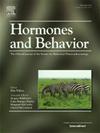皮质酮不太可能表明迁徙的欧洲知更鸟准备好离开
IF 2.4
3区 医学
Q2 BEHAVIORAL SCIENCES
引用次数: 0
摘要
在迁徙过程中,鸟类必须反复决定何时停止中途停留,重新开始迁徙飞行。这样的决定极大地影响了它们的整体迁移成功,并最终影响了它们的适应性。随着能量储备水平的提高,正风的支持和迁徙季节的推进,离开的可能性增加。然而,我们对这一过程背后的内分泌机制的了解仍然不完整。为了评估基线皮质酮(CORT)在调节迁徙离境中的可能作用,我们分析了6个秋季和6个春季迁徙季节在两个附近的中途停留点采集的欧洲知更鸟(Erithacus rubecula)血液中CORT水平与离境概率相关因素之间的关系。与预测相反,在两个迁徙季节,我们观察到瘦鸟的CORT水平较高,这被认为是低离开动机。我们没有发现在日落前后(大概是出发前不久)捕获的肥胖个体的CORT浓度增加的迹象。与离开可能性平行,CORT水平在秋季迁移季节结束时增加,但在春季没有季节性趋势,此时继续迁移的动机更高。最后,CORT水平在秋季与顺风分量呈正相关,而在春季则相反。总之,我们的结果为CORT表明鸣禽的离开准备的假设提供了混合支持。我们认为观察到的关系更符合CORT的代谢功能。我们的研究强调了多年数据和季节性比较在研究诸如离开决定等复杂行为的内分泌调节中的价值。本文章由计算机程序翻译,如有差异,请以英文原文为准。
Corticosterone unlikely indicates departure readiness in migratory European robins
During migration, birds must repeatedly decide when to terminate stopover and resume migratory flight. Such decisions greatly affect their overall migration success and, ultimately, fitness. Departure probability increases with higher levels of energy reserves, positive wind support and progression of the migration season. However, our knowledge of the endocrine mechanisms underlying this process is still incomplete. To evaluate the possible role of baseline corticosterone (CORT thereafter) in regulation of migratory departure, we analyzed the relationships between CORT levels and factors associated with departure probability in European robins (Erithacus rubecula) blood sampled at two nearby stopover sites during six autumn and six spring migration seasons. Contrary to predictions, in both migration seasons we observed higher CORT levels in lean birds, which are assumed to have low departure motivation. We found no indication that CORT concentrations increased in fat individuals captured around sunset, presumably shortly before departure. In parallel with departure likelihood, CORT levels increased towards the end of migration season in autumn, but there was no seasonal trend in spring, when motivation to continue migration is higher. Finally, CORT levels were positively related to tailwind component in autumn, whereas the opposite trend was observed in spring. In summary, our results provide mixed support for the hypothesis that CORT indicates departure readiness in songbirds. We propose that the observed relationships are more consistent with metabolic functions of CORT. Our study highlights the value of multiyear data and seasonal comparisons in studies of the endocrine regulation of such complex behaviors as departure decision.
求助全文
通过发布文献求助,成功后即可免费获取论文全文。
去求助
来源期刊

Hormones and Behavior
医学-行为科学
CiteScore
6.70
自引率
8.60%
发文量
139
审稿时长
91 days
期刊介绍:
Hormones and Behavior publishes original research articles, reviews and special issues concerning hormone-brain-behavior relationships, broadly defined. The journal''s scope ranges from laboratory and field studies concerning neuroendocrine as well as endocrine mechanisms controlling the development or adult expression of behavior to studies concerning the environmental control and evolutionary significance of hormone-behavior relationships. The journal welcomes studies conducted on species ranging from invertebrates to mammals, including humans.
 求助内容:
求助内容: 应助结果提醒方式:
应助结果提醒方式:


